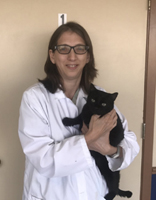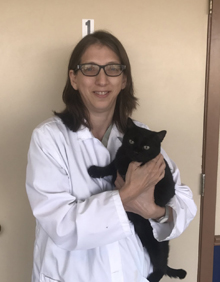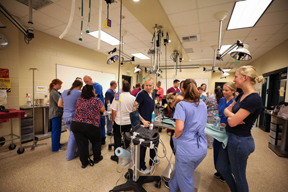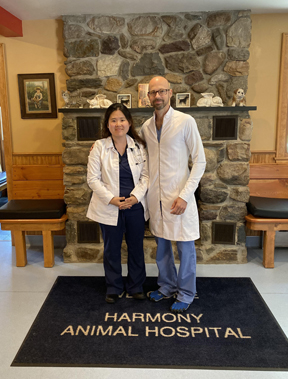
Dr. Kim Buck 220

Photo courtesy Dr. Kim Buck
After ending up in the hospital with pleurisy, Dr. Kim Buck is doubling down on her effort to hire another practitioner so she can scale back her hours. She is shown here a few years ago at her San Antonio, Texas, emergency clinic with a practice cat named Bu.
Dr. Kim Buck is used to covering a lot of shifts as the co-owner and only full-time veterinarian at a small emergency hospital in San Antonio, Texas. But she hit her limit in June. She was working her fifth shift of the week, following a 24-hour haul the previous day, when nine animals were admitted in two hours. A couple of them were very sick.
"My blood pressure went through the roof," Buck told the VIN News Service. "My chest started feeling really bad." Her breath grew short. Her assistant called an ambulance. Buck spent three nights at a hospital and was diagnosed with pleurisy.
"We are going to have to shut down the clinic," Buck remembered thinking. Even as she feared she was having a heart attack, she fretted about staffing her practice. Hiring and retaining ER practitioners has been an ongoing challenge for Buck since she and another veterinarian purchased the hospital six years ago.
During her health scare, the hospital didn't have to close. Her work was covered by part-time and relief veterinarians. Since she returned to work, she is making even more of an effort to hire another practitioner so she can avoid wearing herself down. This new urgency comes at a time when finding emergency veterinarians is especially difficult.
The VIN News Service interviewed 11 emergency veterinary practitioners — several of them owners — representatives of two large hospital chains, and two recruiters. All characterized the situation as a personnel shortage that is "serious," "urgent" and "a crisis."
Help wanted, and wanted, and wanted
Emergency practitioners told VIN News they were drawn to the field by the opportunity to treat a wide variety of conditions and hone a jack-of-all-trades skillset. (All veterinarians practicing emergency medicine — board certified and otherwise — can be called emergency veterinarians. Board-certified emergency veterinarians are criticalists or critical care specialists.) Some said salaries, which tend to be higher than for general practitioners, are a lure but not a key factor. Another perk for some: condensed, intense schedules that allow for extended time off.
However, staffing night, holiday and weekend shifts is not easy. One practitioner called the hours "long and odd." Emergency work can be high-stakes and stressful, and client relations can be fraught. Emergency veterinarians often interact with stressed pet owners for the first time, proffering sometimes expensive interventions with no established relationship of trust to draw on. The circumstances often intimidate young, inexperienced veterinarians and exhaust seasoned ones.
AVMA economist defines 'shortage'
Still, this sector is booming. In little more than a decade, the number of veterinarians in emergency and critical care medicine has grown more than in any other sector of private practice, by 133.5% between 2008 and 2013 and 63.3% between 2013 and 2018, according to the AVMA's 2019 Economic State of the Veterinary Profession report.
In 2018, there were 3,636 emergency/critical care practitioners, according to the AVMA. For those trying to fill emergency clinic schedules, that is not enough, according to Dr. Elisa Mazzaferro, a criticalist and incoming president of the Veterinary Emergency and Critical Care Society (VECCS).
As of today, there are 542 openings for emergency veterinarians and criticalists posted on the VECCS Career Center. Mazzaferro said many postings go unfilled for months.
Owners of independent hospitals told VIN News that they've advertised for more than a year without so much as a nibble.
Stacy Pursell, president of The Vet Recruiter, said there's been a shortage of ER veterinarians for four to five years, and that about half of all emergency veterinary job openings go unfilled.
The crunch affects services. "In recent years, hospitals have had to cut back their hours due to personnel shortages, posting notices of their reduced hours on social media channels like Facebook," Pursell said by email. "I've heard of pet owners having to drive two hours to get emergency care."
Another recruiter, Pamela Harris of VetNetAmerica, sees the impact hitting a particular subset of hospitals. "Small animal practices that once offered emergency services have either significantly reduced their emergency hours or completely eliminated the service due to an inability to staff ER veterinarians," Harris said in an email.
That translates into some pet owners having no nearby emergency specialty care, or pet owners facing longer waits for treatment, Mazzaferro said.
"We have called it a crisis for a long time now," said Dr. James Barr, a criticalist and chief medical officer at BluePearl Specialty and Emergency Pet Hospitals. With nearly 500 emergency veterinarians working at more than 90 hospitals in the U.S., BluePearl currently has openings for 120 more.
However, the company has not permanently reduced hours or shuttered any locations, and Barr said he has not heard about other practices closing down.
"Most of the time, it's not that you can't keep the doors open, but instead of three doctors, you may only have two," he said. "And, that actually creates a strain on those two doctors because they see more cases … that generates long shifts and that creates more stress on them."
Under these circumstances, patient care and practitioner well-being can deteriorate.
Dr. Tony Johnson, a criticalist for nearly 20 years, has seen it firsthand. "I have worked at a few severely undermanned places where patient care definitely suffered until some fresh blood was brought on board," he said. "And an undermanned place contributes to the stress and makes the revolving door even worse. So these are closely related — no one wants to do crummy medicine, and those who find themselves doing it will often seek out greener pastures."
Emergency hospitals proliferate
Harris described the demand for emergency veterinarians as "intensive and extensive." She considers it part of an overall shortage of veterinarians but with unique drivers.
First among them: the expansion of the number of emergency and specialty practices. "For every ER/specialty practice in an area 10 years ago, there are three or more today," she said. No agency or organization tracks the number of practices in the U.S., but Barr said that estimate sounds right.
"That's economics that's driving that," he said. "It's not that these [ERs] are popping up, and folks don't have the caseload. Everyone is busy."
There is an expanding demand for veterinary care in general, Barr said, "and outstripping that is the demand for emergency and specialty care …. People are willing to treat serious and acute diseases."
Dr. Mike Thomas owns 11 practices in the Indianapolis area and Wheaton, Illinois — three with 24-hour emergency care — and employs 18 emergency doctors. He believes one of many factors driving increased demand for emergency services is the cost of primary care. "People are waiting too long to come in," he said, referring to pet owners putting off visits to a clinic out of concern over the cost. It's a self-defeating situation, since emergency care tends to be more expensive.
Harris suspects another hurdle to filling positions: a generational shift in attitudes toward long work hours. "Gone are the days when doctors were willing to work 50 to 60 hours per week," she said.
Thomas described a similar trend. "The shortage is … exacerbated by a change of endurance by doctors," he said. "It now takes three doctors to cover what two did for many years. This translates to a 50% increase in the number needed to cover 24/7 hours."
It's part of the "changing value system of young veterinarians," he said.
Practice owners say younger practitioners are seeking work-life balance like never before. Mazzaferro, incoming VECCS president, offers kudos to those who recognize the importance of balance early on.
"It's not wrong to say, 'I'm not willing to do that,' " she said. It's a trend, she said, that has a two-fold impact on emergency medicine: Younger veterinarians — general practitioners and specialists alike — often don't want to work nights, holidays and weekends. And when general practitioners take time off or won't stay late, more cases end up at veterinary emergency practices.
"They are preserving their work/life balance by deflecting cases," Mazzaferro said.
Buck in San Antonio said another drag on hiring emergency veterinarians might have something to do with the profession's changing gender demographics, which is now more than 60% women. "I know I am going to get hit for saying this," she said. "Some of it might have to do with the number of women in the field. I remember during my child-bearing years, I tried not to work so much." While her children were growing up, she moved into general practice. Once they were older, she returned to emergency work.
Is better pay a solution?
AVMA chief economist Matt Salois does not use the term "shortage" to describe the hiring crunch. (See sidebar.) In economic terms, a workforce shortage exists when no amount of money can fill the gap. Salois believes that an employer who offered 1.5 times the average salary would have no difficulty finding takers for an ER job.
That strategy, however, is not available to most employers, Salois acknowledged. "[T]hey can't do that because they are constrained to offer a salary based on the additional revenue or income a veterinarian can provide," he explained by email. "That additional revenue/profitability is a function of the demand for veterinary services from the pet owner."
Salaries for emergency veterinarians and criticalists vary widely based on location, schedules, and whether it's a private practice or university hospital. Mazzaferro said it's not uncommon for an emergency veterinarian to make $115,000 to $120,000.
The average salary for board-certified emergency and critical care veterinarians was $142,000 in 2019, according to the AVMA. The median pay for veterinarians in 2019 was $95,460, according to the U.S. Bureau of Labor Statistics.
How much incremental increases in salary would improve the hiring outlook is an open question.
Two practice owners said they haven't had the opportunity to find out how candidates would react to the proposed salaries, since no one even responded to their job postings. None of the emergency veterinarians who spoke to VIN News identified pay as the reason they were drawn to the field or were considering leaving it.
"I tend to think the ER salaries are better than GP, but the stress and crazy hours are considerable," Johnson said. "I think most go into it for the excitement of ER and the flexibility in scheduling. I think work environment and schedule probably top the money for most."
Fostering a more sustainable specialty
The majority of those in emergency medicine who talked to VIN News did not suggest expanding the number of graduates from veterinary programs, which was floated as a response to reported associate veterinarian shortages last year. Dr. Ryan Epple, who owns a 24-hour hospital in northwest New Jersey, said he worries that graduating more veterinarians could create a new problem: an oversupply down the road.
Instead, practitioners and practice owners are focused on improving preparation, ongoing support and recognition at various career stages for this particular cadre.
Working with the American College of Veterinary Emergency and Critical Care (ACVECC), which oversees residencies and certification for emergency specialists, VECCS created a joint task force last year to develop initiatives to attract and retain more veterinarians.
Fueled by the results of an internal survey of member doctors, technicians and practice managers, the task force recommended additional levels of training and certification. The aim is "to help entry level veterinarians feel and become more qualified to become emergency veterinarians, as well as provide job satisfaction to seasoned emergency veterinarians so that they can hopefully stay within the field of emergency and critical care," Mazzaferro said.
Under consideration is a three-pronged approach that could include a certification program for students; immersive internships for recent graduates or general practice veterinarians hoping to move into emergency medicine; and a certificate of achievement for experienced emergency practitioners who don't want to pursue residency and board-certification.
Residencies take three years to complete, during which residents usually are paid below-market rates, Mazzaferro said.
There are currently 736 ACVECC diplomates, and the college adds about 50 a year. These board-certified specialists tend to oversee and support emergency doctors who are not board-certified and to run emergency and intensive care units, Dr. Armelle de LaForcade, ACVECC executive secretary explained in an email.
Expand emergency training in veterinary school
Historically, new graduates do not begin their careers in emergency medicine, due to the pace and pressure of the job and limited experience in veterinary school. However, de Laforcade said there is more to it.
"Turns out, finishing veterinary students report that they are often discouraged by faculty in their institutions about considering a career in emergency medicine," de Laforcade said. "Some schools have no specific curriculum dedicated to emergency medicine."
For the past few years, the University of Florida College of Veterinary Medicine independently has been developing a student certificate program for emergency medicine. It's the first of its kind in the country, according to Dr. Leo Londoño, a UF faculty member who is leading the effort.
"A lot of students are scared to go into ER," Londoño said. "That's what we are trying to address."
The program includes elective summer classes for students in their first and third years. During their clinical year, they must take three emergency and critical care rotations.
The certificate was not designed to address a shortage, Londoño said; rather, it was created to provide an opportunity for interested students to gain clinical and practical knowledge in emergency medicine. However, he said, preparing graduates to succeed in emergency medicine straight out of school may increase the number of young veterinarians seeking work in that sector.
Londoño heads the committee that is adapting the UF's emergency certification for ACVECC/VECCS, which hopes to launch a national online version, possibly as early as next year. The UF certificate, which was scheduled to begin in August, has been delayed until 2021 because pandemic-related restrictions may limit opportunities for in-person clinical practice.
On-the-job immersion
EmERge program 288

BluePearl Specialty and Emergency Pet Hospital photo
BluePearl veterinarians participated in ultrasound training in Florida in 2019 as part of an immersive one-year emergency skills training program.
ACVECC's one-on-one immersion training program for new graduates is being developed simultaneously to private emergency practices, hospital groups and corporate chains developing their own more rigorous training and mentorship programs.
BluePearl is ahead of ACVECC in this work, Mazzaferro said.
"We've had to be innovative a bit in attracting doctors to our hospitals," BluePearl's Barr said. "That includes wages, but that's not enough."
In 2018, BluePearl launched a one-year immersive emergency skills training program with a formal mentorship and didactic rounds, given the name EmERge. Participants are paid a regular salary during the year and commit to work three years for BluePearl after completing the program.
"It's only been a very recent occurrence that new veterinarians have been able to come from vet school and go into emergency practice, because it does require expertise," Barr said. "[T]he time frame you have to talk about the case, work it up, establish a relationship with the client and then go through all those conversations is sped up. Experience is required to do that in an efficient way."
So far, 52 associates are in or have completed the program. Many, but not all, are recent graduates.
National Veterinary Associates (NVA) said it, too, has found it challenging to find emergency doctors and criticalists. With more than 985 general practice, emergency and specialty hospitals and pet boarding/daycare facilities in the United States, Canada, Australia, New Zealand and Singapore, NVA is one of the largest practice owners in the country.
Spokesperson Laura Koester provided statements from NVA's specialty and emergency care team based on VIN News questions. They say in part:
"To deal with the challenge, NVA focuses efforts on finding great doctors and investing in programs to help doctors develop. Specifically, we built a dedicated Specialty and ER recruiting team to find doctors and match the right doctor to the right practice. In addition, we have invested in mentorship and development programs for Specialty and Emergency/Critical care doctors. Plus, our medical leaders of each hospital are empowered to determine their own culture and medical practices."
Dr. Ryan Epple 288

Photo courtesy Dr. Ryan Epple
After a run of long hours and endless work weeks, Drs. Minjeong Gwon and Ryan Epple, partners at a New Jersey general and emergency practice, recently managed to fill out their staff.
With these strategies, NVA said it retains doctors for a minimum of one year at levels typically above 90%. The company said it has 30 specialty or emergency doctors positions open, 80% of which are for growth, and has hired nearly 50 specialty and emergency doctors since January.
One practice turns a corner
"Hopefully some people smarter then I will figure out the cure for this malady of no veterinarians answering job postings, and fix it – because sleeping away from home and children 10 nights out of 14 and staffing 80 hrs/wk is burdensome in more ways than one," Dr. Ryan Epple posted in December on a message board of the Veterinary Information Network, an online community for the profession and parent of VIN News.
Epple is committed to emergency work. After graduating from the University of Pennsylvania veterinary school in 2003, he was hired as an associate at an emergency hospital in Delaware. He was brought along through an informal mentoring program. Within months, he was handling overnight shifts solo.
Eventually, he went to work for his father, a veterinarian who owned a general practice in New Jersey. After taking over that practice in 2008, Epple expanded services to include 24-hour emergency care. Initially, business was slow enough that doctors worked on an on-call basis.
As the practice grew, Epple began to struggle to find associates who would take overnight shifts. In the past few years, staffing became a bigger headache, especially after an associate left last year. Epple said he never considered selling — not even at a premium — to a corporate consolidator. Nor has he seriously considered reducing his hours. He said he loves emergency medicine and feels an obligation to his community.
The picture improved this year. The former associate returned. Another associate, Dr. Minjeong Gwon, bought into the practice and became a partner in July. And, a recent graduate, who had done an externship at the hospital, joined the team as a staff member and mentee. Today, Epple said, "Things are looking better."